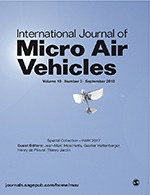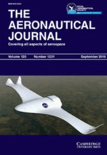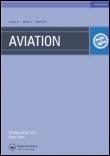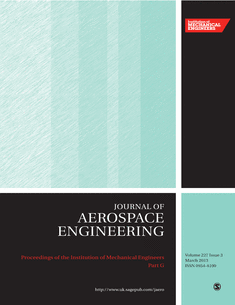
Aerospace
Scope & Guideline
Unlocking the Future of Aerodynamics and Propulsion
Introduction
Aims and Scopes
- Aerospace Propulsion Systems:
Research on various propulsion technologies, including liquid and solid rocket engines, hybrid propulsion systems, and electric propulsion, focusing on efficiency, performance, and environmental impact. - Aerodynamics and Fluid Dynamics:
Studies on aerodynamic performance, flow characteristics, and fluid-structure interactions related to aircraft, spacecraft, and UAVs, utilizing both experimental and computational fluid dynamics (CFD) methodologies. - Control Systems and Guidance:
Development of advanced control techniques for aerospace applications, including guidance, navigation, and control (GNC) systems for aircraft and spacecraft, with a focus on robustness and adaptability. - Structural Analysis and Materials:
Investigation of structural integrity, fatigue, and failure mechanisms of aerospace materials and components, emphasizing the use of composite materials and innovative manufacturing techniques. - Safety and Reliability Engineering:
Research aimed at enhancing the safety and reliability of aerospace systems through risk assessment, fault detection, and health management methodologies. - Sustainable Aviation Technologies:
Exploration of eco-friendly technologies and practices in aviation, including the development of sustainable fuels, energy-efficient aircraft designs, and noise reduction strategies.
Trending and Emerging
- Electric and Hybrid Propulsion Systems:
There is a growing interest in electric and hybrid propulsion technologies, reflecting the industry's push towards reducing emissions and enhancing fuel efficiency. - Autonomous Systems and UAV Technologies:
Research on unmanned aerial vehicles (UAVs) and autonomous systems is on the rise, with a focus on navigation, control, and applications in various fields such as delivery and surveillance. - Digital Twins and Simulation Technologies:
The use of digital twins and advanced simulation methodologies is increasing, enabling better predictions of performance and facilitating real-time monitoring and control of aerospace systems. - Artificial Intelligence and Machine Learning Applications:
AI and machine learning techniques are increasingly applied in various aerospace domains, including predictive maintenance, flight path optimization, and anomaly detection. - Sustainable Materials and Manufacturing Processes:
There is a trend towards researching sustainable materials and innovative manufacturing processes, such as additive manufacturing and bio-based materials, to minimize environmental impact. - Advanced Aerodynamics and Flow Control Techniques:
Emerging studies focus on novel aerodynamic designs and active flow control methods to enhance performance and reduce drag, particularly in hypersonic and supersonic applications.
Declining or Waning
- Traditional Aeronautics:
Research centered on conventional aerodynamics and flight mechanics has decreased, possibly due to the increasing focus on innovative technologies such as electric propulsion and UAV systems. - Static Structural Analysis:
The emphasis on static structural analysis of aerospace components has waned, as more dynamic and complex analyses, including fluid-structure interactions and real-time simulations, gain prominence. - Conventional Materials Research:
Studies focused on traditional materials like aluminum and steel are becoming less frequent, with a shift towards advanced composites and novel material systems for aerospace applications. - Basic Flight Dynamics:
Basic studies on flight dynamics without integration into broader systems or applications have declined, as there is a greater emphasis on integrated and multidisciplinary approaches.
Similar Journals

International Journal of Micro Air Vehicles
Unleashing Potential in Micro Air Vehicle DevelopmentThe International Journal of Micro Air Vehicles, published by SAGE Publications Ltd, stands as a pioneering platform for cutting-edge research in the rapidly evolving field of micro air vehicle (MAV) technology. With an ISSN of 1756-8293 and an E-ISSN of 1756-8307, this journal caters to a diverse readership, including aerospace engineers, researchers, and industry professionals who are at the forefront of innovation in aerospace engineering. It holds a commendable position within the Q3 category of Aerospace Engineering for 2023 and is ranked 65th out of 153 in Scopus, placing it in the 57th percentile among its peers. As a vital resource since its inception in 2010, the journal emphasizes advancements in design, performance, and applications of MAVs, while facilitating knowledge sharing and collaboration across disciplines. Although it operates on a subscription model, the journal ensures accessibility of pivotal research findings for professionals and scholars alike, aiming to shape the future of aerospace applications through rigorous academic inquiry.

Journal of the Global Power and Propulsion Society
Driving the Future of Aerospace and Mechanical EngineeringJournal of the Global Power and Propulsion Society, published by GLOBAL POWER PROPULSION SOC, is a premier open-access journal established in 2017, dedicated to the dissemination of innovative research and advancements in the fields of aerospace engineering, industrial and manufacturing engineering, and mechanical engineering. Based in Zug, Switzerland, this journal provides a critical platform for researchers, professionals, and students to engage with cutting-edge studies and emerging technologies that are pivotal to the aerospace and propulsion sectors. With an impressive categorization in the Q2 quartile for multiple engineering specialties in 2023, the journal reflects its commitment to quality and rigor in its peer-reviewed articles. Moreover, it holds substantial visibility in the academic community, as evidenced by its Scopus rankings. The Journal of the Global Power and Propulsion Society stands at the intersection of innovation and collaboration, aiming to foster knowledge sharing globally while enhancing the operational capabilities of power and propulsion technologies.

AIRCRAFT ENGINEERING AND AEROSPACE TECHNOLOGY
Elevating aircraft engineering with cutting-edge insights.AIRCRAFT ENGINEERING AND AEROSPACE TECHNOLOGY, published by Emerald Group Publishing Ltd, is a leading peer-reviewed journal dedicated to advancing the fields of aerospace engineering and technology. With a strong emphasis on innovative research, the journal aims to bridge theoretical developments and practical applications within the aerospace sector. Although the journal does not currently offer open access, it continues to enrich the academic community's understanding of aircraft design, maintenance, and engineering processes, making it a crucial resource for researchers, professionals, and students alike. By fostering a rigorous dialogue among experts, AIRCRAFT ENGINEERING AND AEROSPACE TECHNOLOGY ensures the dissemination of cutting-edge findings and promotes sustainable practices in the aerospace industry, highlighted by its commitment to high-quality scholarship.

AERONAUTICAL JOURNAL
Pioneering research in aeronautical engineering.Aeronautical Journal, published by Cambridge University Press, is a premier scholarly journal dedicated to advancing the field of aerospace engineering. With a notable impact factor, this journal holds a strong position in the academic community, ranked #53 out of 153 in the Scopus category of Aerospace Engineering, placing it in the 65th percentile. The journal has been providing a platform for groundbreaking research since its inception in 1969, and continues to be a vital resource for researchers, professionals, and students involved in aeronautics. As a Q2 journal in the 2023 Aerospace Engineering category, it offers high-quality articles that cover a range of topics within the discipline, contributing to the ongoing discourse and innovation in aerospace technologies. Although not an open-access journal, it remains accessible to a vast readership through institutional subscriptions and partnerships. The Aeronautical Journal is a crucial publication for those seeking to stay at the forefront of aerospace research and development.

Aviation
Catalyzing collaboration in aerospace engineering advancements.Aviation, published by Vilnius Gediminas Technical University, is a leading open-access journal dedicated to the dynamic field of aerospace engineering, with an ISSN of 1648-7788 and E-ISSN of 1822-4180. Established in 2004 and set to converge in 2024, this journal aims to disseminate high-quality research that advances the understanding and application of aerospace technology. With an impact factor reflective of its contribution to the discipline, Aviation ranks at Q4 in the Aerospace Engineering category and occupies the 80th position out of 153 in Scopus, highlighting its growing significance among scholarly publications. By providing free access to its content since 2018, the journal enhances its reach and encourages collaborative efforts in the academic community, catering to researchers, professionals, and students eager to explore innovative studies and findings within aerospace engineering. Based in Lithuania, this journal serves as a vital resource for those aiming to contribute to the future of aviation.

International Journal of Turbomachinery Propulsion and Power
Empowering innovation in energy systems and propulsion technology.The International Journal of Turbomachinery Propulsion and Power, published by MDPI, is a pivotal scholarly platform devoted to advancing the field of turbomachinery, propulsion technology, and power systems. Since its inception in 2016, this open-access journal has provided an invaluable resource for researchers, professionals, and students within the realms of Aerospace Engineering, Energy Engineering, and Mechanical Engineering. With its current ranking in the Q3 category across these disciplines and its strategic placement in Scopus, the journal facilitates the dissemination of cutting-edge research findings and innovative solutions. The commitment to open access, effective from 2017, ensures that high-quality research is readily accessible, fostering collaboration and knowledge sharing in the global academic community. As it continues to expand its scope through 2024, the journal remains a crucial avenue for discussion, experimentation, and advancement in turbomachinery and energy-related studies.

Journal of Aerospace Technology and Management
Navigating the Skies of Research and Technology.The Journal of Aerospace Technology and Management, published by the Instituto de Aeronáutica e Espaço (IAE), serves as a pivotal platform for the dissemination of innovative research in the fields of Aerospace Engineering and Computational Mechanics since its inception in 2009. With an ISSN of 1984-9648 and an E-ISSN of 2175-9146, this Open Access journal facilitates unrestricted access to quality research, fostering knowledge sharing and collaboration among researchers, professionals, and academic institutions worldwide. Based in Brazil, it ranks in the Q3 category according to the latest metrics (2023), highlighting its growing influence and relevance in the competitive landscape of aerospace studies. The journal currently boasts notable Scopus rankings, ensuring that published works achieve widespread recognition and impact within the scientific community. Its diverse scope encompasses a blend of theoretical and applied research, making it an indispensable resource for those seeking to explore groundbreaking advancements in aerospace technologies and management.

PROCEEDINGS OF THE INSTITUTION OF MECHANICAL ENGINEERS PART G-JOURNAL OF AEROSPACE ENGINEERING
Pioneering Insights in Aerospace EngineeringPROCEEDINGS OF THE INSTITUTION OF MECHANICAL ENGINEERS PART G-JOURNAL OF AEROSPACE ENGINEERING, published by SAGE PUBLICATIONS LTD, stands as a pivotal resource for those immersed in the disciplines of aerospace and mechanical engineering. With an ISSN of 0954-4100 and E-ISSN of 2041-3025, this journal not only contributes to the academic community but also reflects a robust commitment to advancing knowledge within these fields. Operating from the United Kingdom, it has garnered a respectable reputation, evidenced by its category quartiles—ranking Q3 in both Aerospace Engineering and Mechanical Engineering as of 2023. Established in 1989, the journal has evolved substantially over the years, serving as a platform for groundbreaking research and innovative methodologies. Researchers, professionals, and students alike will find a wealth of insights that foster collaboration and advance the frontiers of engineering. Although currently not available as an Open Access publication, the journal remains a critical reference point for those looking to deepen their understanding and contribute to ongoing developments in aerospace technology.

Journal of the Korean Society for Aeronautical and Space Sciences
Connecting Researchers for a Thriving Aerospace CommunityThe Journal of the Korean Society for Aeronautical and Space Sciences is a dedicated platform for the dissemination of cutting-edge research in the fields of aerospace engineering and space sciences. Published by the esteemed Korean Society for Aeronautical & Space Sciences, this journal aims to bring together innovative findings and technological advancements from around the globe, thereby contributing to the ongoing development of the aerospace sector. Operating from South Korea, the journal holds an ISSN of 1225-1348 and an E-ISSN of 2287-6871, catering to both print and digital scholarly communication. Although categorized in Q4 within the Aerospace Engineering segment and ranked 139 out of 153 on Scopus, the journal plays a crucial role in fostering research collaboration and knowledge exchange among professionals, researchers, and students alike. With converged years from 2019 to 2024, it continuously seeks to enhance its contributions to the academic community through rigorous peer review and publication of original research. Given the evolution of aerospace technologies, this journal is vital for anyone involved in aeronautical research, ensuring that their work reaches the right audience.

Advances in Aircraft and Spacecraft Science
Unlocking New Horizons in Aerospace ResearchAdvances in Aircraft and Spacecraft Science is a distinguished journal published by TECHNO-PRESS, focusing on the rapidly evolving fields of aerospace engineering and fluid dynamics. With an ISSN of 2287-528X and an E-ISSN of 2287-5271, this journal is an invaluable resource for researchers, professionals, and students dedicated to advancing knowledge in aircraft and spacecraft technologies. Established in 2014, the journal is committed to disseminating high-quality research findings and innovative methodologies, ensuring that cutting-edge studies can be accessed globally. Despite its current position in the Q4 category for both aerospace engineering and fluid flow transfer processes, it continues to carve a niche in the academic landscape, with Scopus rankings highlighting its contribution to these fields. Operating from South Korea, Advances in Aircraft and Spacecraft Science aims to inspire collaboration and knowledge-sharing among scholars, fostering advancements that drive the aerospace industry forward.